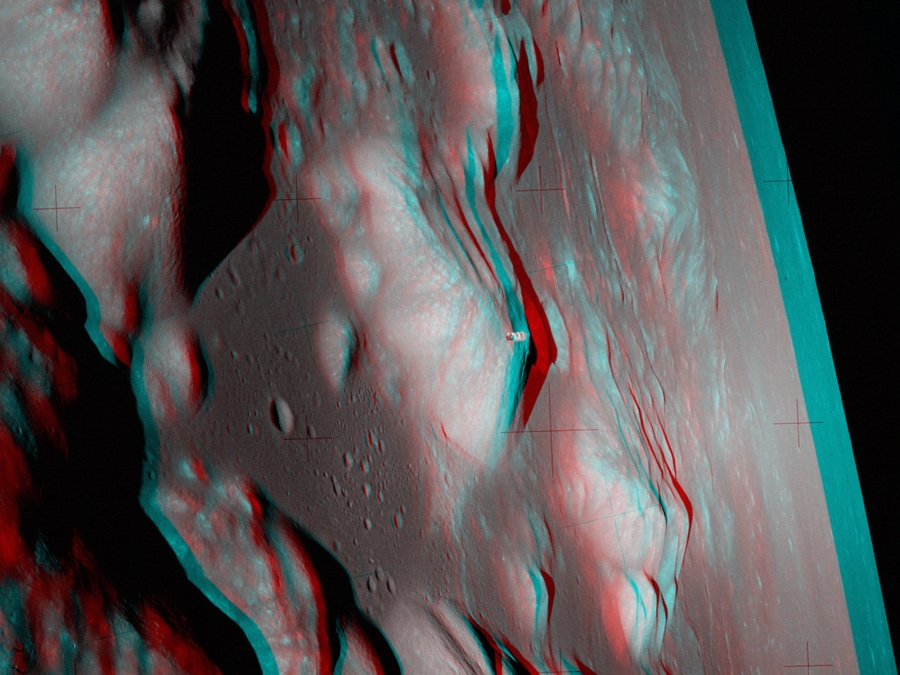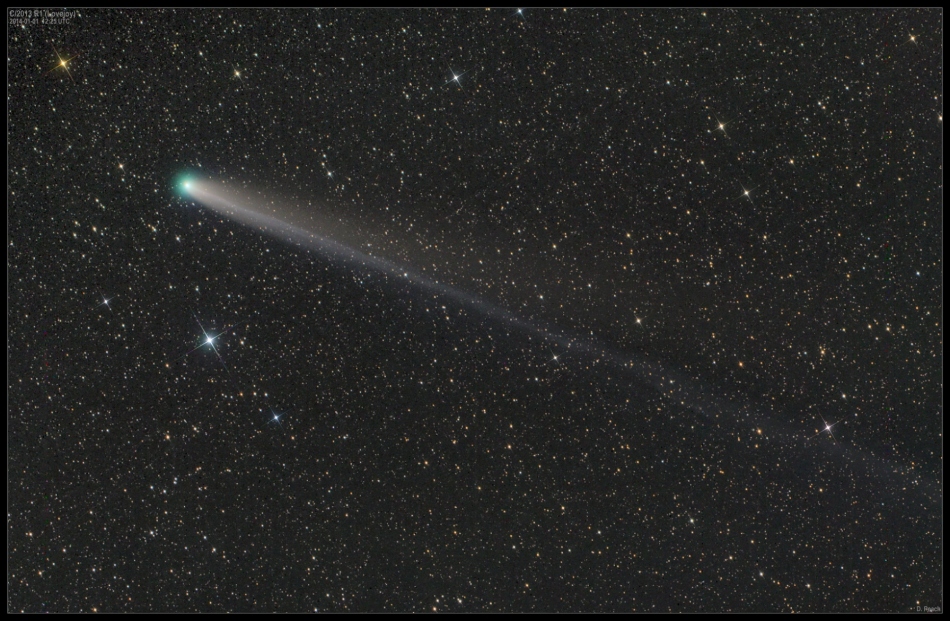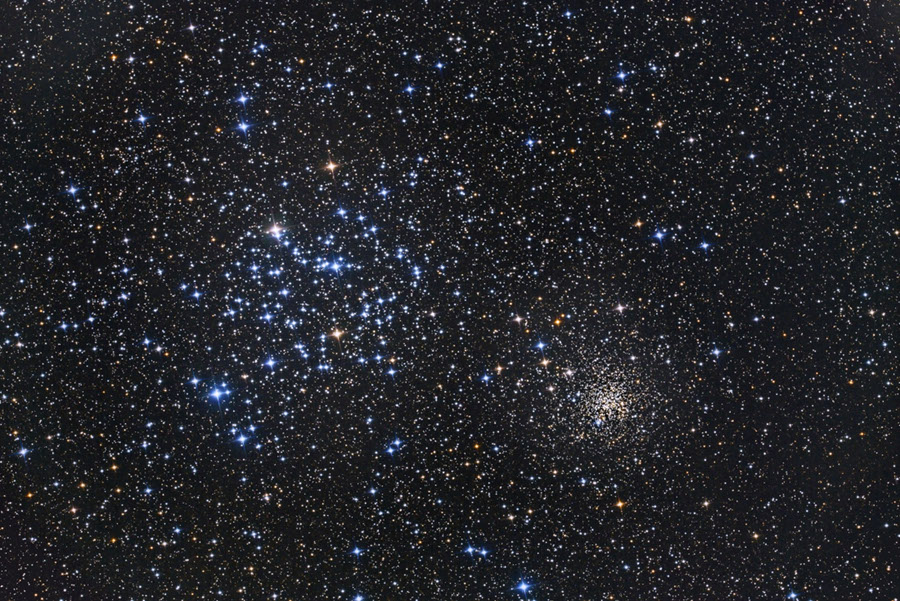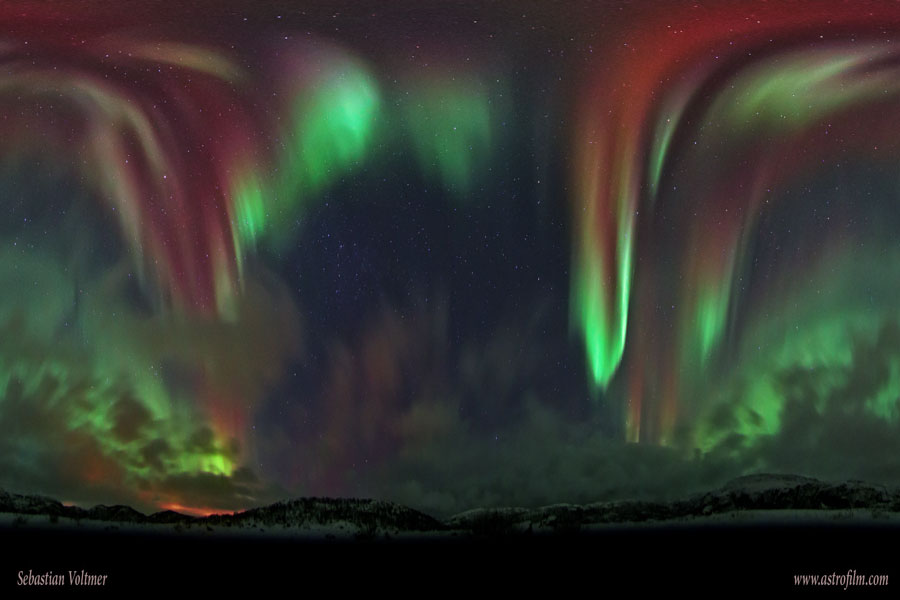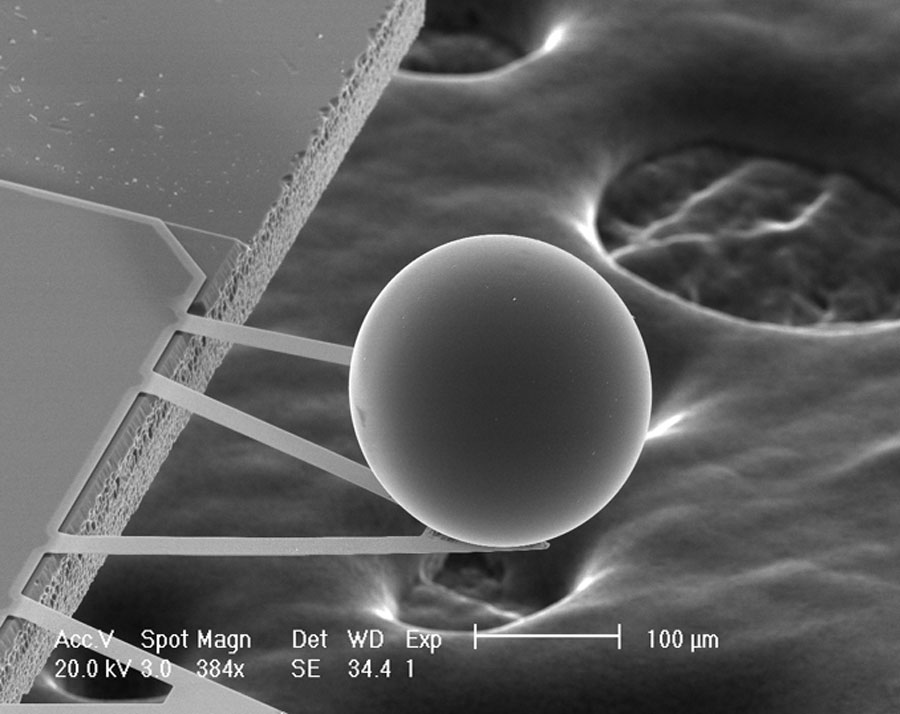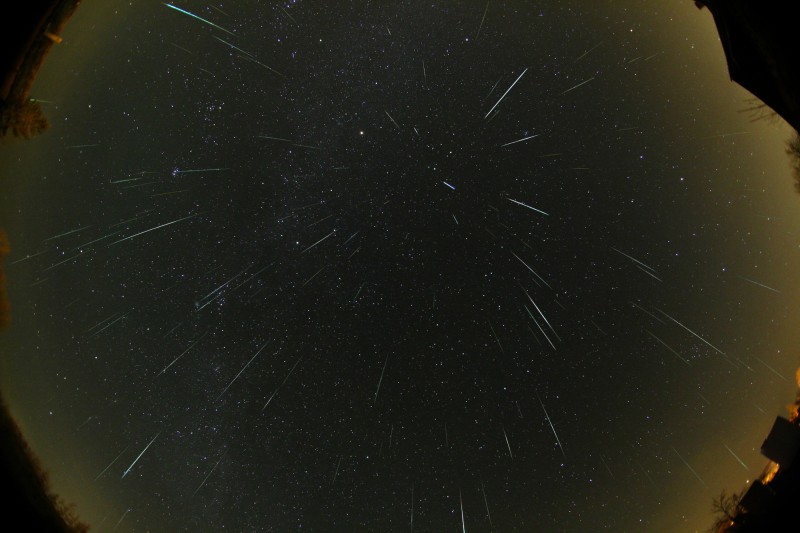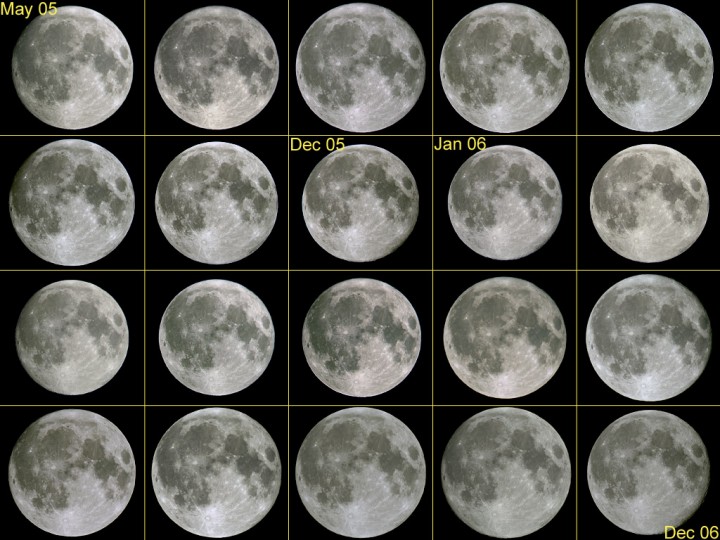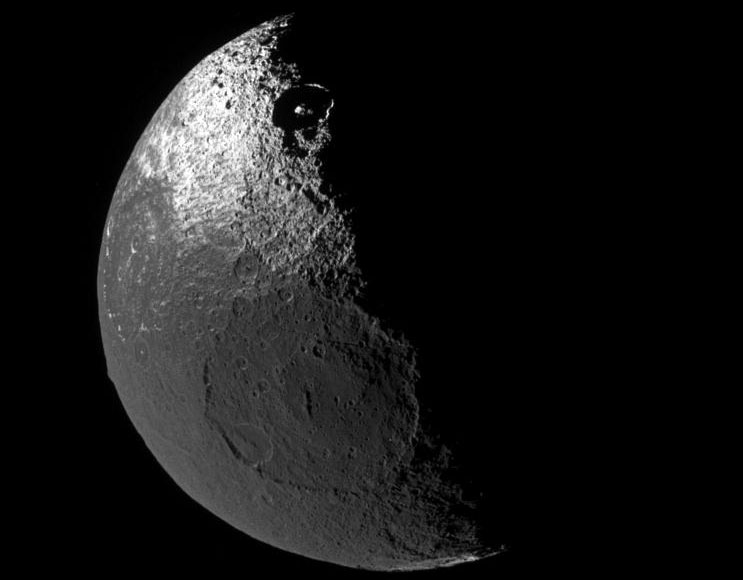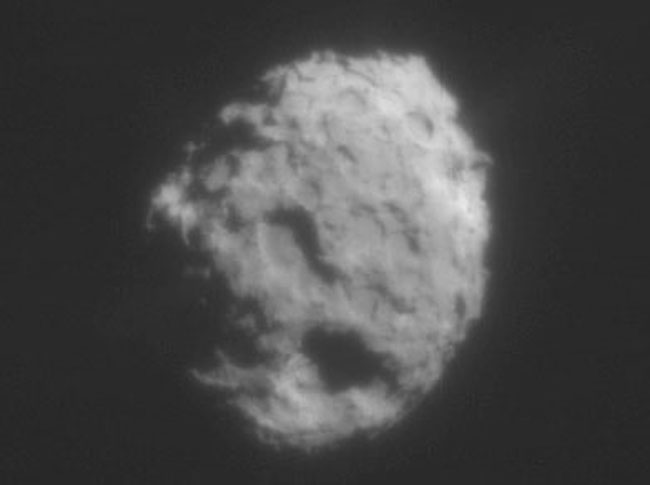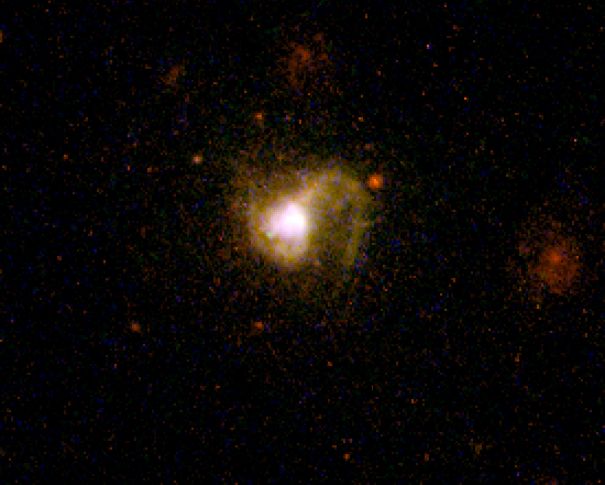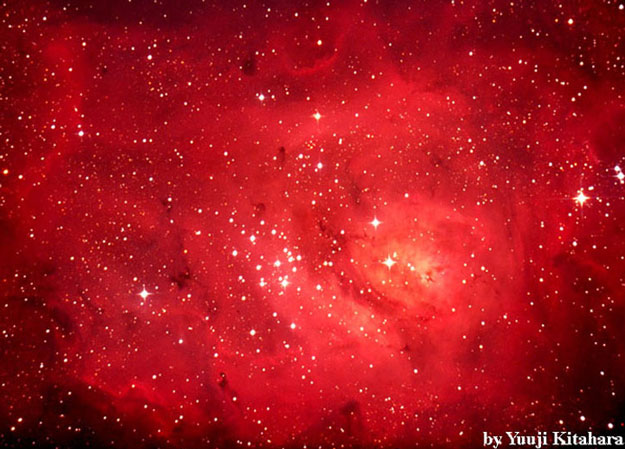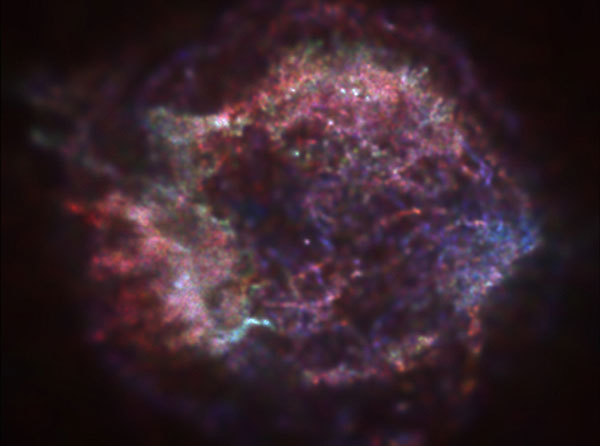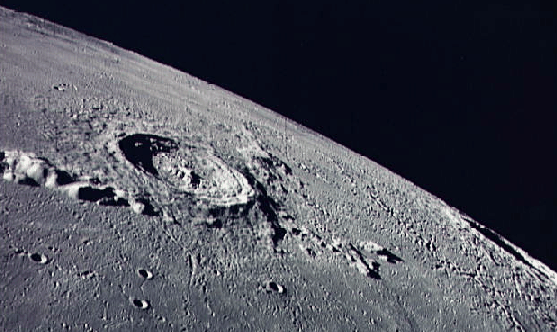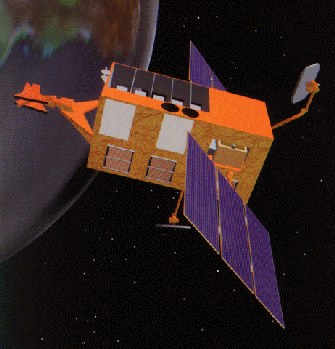| << Previous | Index | Next >> |
2015 Get out your red/blue glasses and check out this awesome stereo view of another world. The scene was recorded by Apollo 17 mission commander Eugene Cernan on December 11, 1972, one orbit before descending to land on the Moon. The stereo anaglyph was assembled from two photographs (AS17-147-22465, AS17-147-22466) captured from his vantage point on board the Lunar Module Challenger as he and Dr. Harrison Schmitt flew over Apollo 17's landing site in the Taurus-Littrow Valley. The broad, sunlit face of the mountain dubbed South Massif rises near the center of the frame, above the dark floor of Taurus-Littrow to its left. Beyond the mountains, toward the lunar limb, lies the Moon's Mare Serenitatis. Piloted by Ron Evans, the Command Module America is visible in orbit in the foreground against the South Massif's peak.
2014 A rival to vanquished Comet ISON in 2013, Comet Lovejoy (C/2013 R1) still sweeps through early morning skies, captured in this starry scene on New Year's day. The frame stretches some 3.5 degrees (about 7 full moons) across a background of faint stars in the constellation Hercules. Only just visible to the naked eye from dark sites before dawn, Lovejoy remains a good target for the northern hemisphere's binocular equipped skygazers. But this deep exposure shows off Lovejoy's beautiful tails and tantalizing greenish coma better than binocular views. Not a sungrazer, this Comet Lovejoy made its closest approach to the Sun around December 22, looping high above the ecliptic plane. Now headed for the outer Solar System, Lovejoy began the new year about 6.7 light-minutes from planet Earth.
2013 Open clusters of stars can be near or far, young or old, and diffuse or compact. Found near the plane of our Milky Way galaxy, they contain from 100 to 10,000 stars, all of which formed at nearly the same time. Bright blue stars frequently distinguish younger open clusters. M35, on the upper left, is relatively nearby at 2800 light years distant, relatively young at 150 million years old, and relatively diffuse, with about 2500 stars spread out over a volume 30 light years across. An older and more compact open cluster, NGC 2158, is at the lower right. NGC 2158 is four times more distant than M35, over 10 times older, and much more compact with many more stars in roughly the same volume of space. NGC 2158's bright blue stars have self-destructed, leaving cluster light to be dominated by older and yellower stars. Both clusters are seen toward the constellation of Gemini.
2012 Higher than the highest building, higher than the highest mountain, higher than the highest airplane, lies the realm of the aurora. Auroras rarely reach below 60 kilometers, and can range up to 1000 kilometers. Aurora light results from energetic electrons and protons striking molecules in the Earth's atmosphere. Frequently, when viewed from space, a complete aurora will appear as a circle around one of the Earth's magnetic poles. The above wide angle image, horizontally compressed, captured an unexpected auroral display that stretched across the sky one month ago over eastern Norway.
2011
[imghover6=http://apod.nasa.gov/apod/image/1101/wi ... stlake.jpg]http://apod.nasa.gov/apod/image/1101/wi ... otated.jpg[/imghover6]Credit & Copyright: Jimmy Westlake (Colorado Mountain College)
2010 This tiny ball provides evidence that the universe will expand forever. Measuring slightly over one tenth of a millimeter, the ball moves toward a smooth plate in response to energy fluctuations in the vacuum of empty space. The attraction is known as the Casimir Effect, named for its discoverer, who, 50 years ago, was trying to understand why fluids like mayonnaise move so slowly. Today, evidence is accumulating that most of the energy density in the universe is in an unknown form dubbed dark energy. The form and genesis of dark energy is almost completely unknown, but postulated as related to vacuum fluctuations similar to the Casimir Effect but generated somehow by space itself. This vast and mysterious dark energy appears to gravitationally repel all matter and hence will likely cause the universe to expand forever. Understanding vacuum fluctuations is on the forefront of research not only to better understand our universe but also for stopping micro-mechanical machine parts from sticking together.
2009 Some 7,000 light-years away, this pair of open or galactic star clusters is an easy binocular target, a lovely starfield in the northern constellation Perseus. Also visible to the unaided eye from dark sky areas, it was cataloged in 130 BC by Greek astronomer Hipparchus. Now known as h and chi Persei, or NGC 869(above right) and NGC 884, the clusters themselves are separated by only a few hundred light-years and contain stars much younger and hotter than the Sun. In addition to being physically close together, the clusters' ages based on their individual stars are similar - evidence that both clusters were likely a product of the same star-forming region.
2008 Dust from curious near-Earth asteroid 3200 Phaethon seems to fall from the constellation Gemini in this fisheye skyview. The composite image was recorded over four December nights (12-15) just last year from Ludanyhalaszi, Hungary. Of course, the streaks are meteor trails from the annual Geminids meteor shower. The work of astronomer Erno Berko, the finished picture combines 113 different frames and captures 123 separate meteors. The Geminids is one of the northern skies most reliably performing meteor showers and did not disappoint last year. Under good conditions some skywatchers reported well over 100 meteors per hour near the December 14/15 peak for the Geminids in 2007. Look up tonight and you might see the 2008 Quadrantids.
2007 In celebration of tonight's Full Moon, the first of 2007, consider this grid of twenty Full Moons. From upper left to lower right, the images represent every lunation from May 2005 through December 2006. The consecutive Full Moons are all shown at the same scale, so unlike the famous Moon Illusion the change in apparent size seen here is real. (For example, compare early and late 2006 Full Moons.) The change is caused by the variation in lunar distance due to the Moon's significantly non-circular orbit. A subtler change in appearance can also be noticed on close examination, as the Moon seems to wobble and rock slightly from one Full Moon to the next. This effect, known as libration, is more dramatic and easier to see in a twenty frame movie comparing these twenty Full Moons.
2006 Why are vast sections of Iapetus as dark as coal? No one knows for sure. Iapetus, the third largest moon of Saturn, was inspected again as the Saturn-orbiting robot Cassini spacecraft swooped past the enigmatic world again late last year. The dark material covers most of the surface visible in the above image, while the small portion near the top that appears almost white is of a color and reflectance more typical of Saturn's other moons. The unknown material covers about half of the 1,500 kilometer wide moon. The material is so dark that it reflects less than five percent of incident sunlight, yet overlays craters indicating that it was spread after the craters were formed. Iapetus has other unexplained features. The bright part of Iapetus is covered with unexplained long thin streaks. The orbit of Iapetus is also unusual, being tilted to the plane of Saturn's orbit by an unusually high fifteen degrees. A strange ridge about 13 kilometers high crosses much of Iapetus near the equator and is visible near the bottom. Oddly, this ridge is almost exactly parallel with Iapetus' equator. The exact shape of Iapetus remains undetermined, but images indicate that it is quite strange -- something like a walnut. Research into the formation and history of mysterious Iapetus is active and ongoing.
2005 Perhaps the most famous star cluster on the sky, the Pleiades can be seen without binoculars from even the depths of a light-polluted city. Also known as the Seven Sisters and M45, the Pleiades is one of the brightest and closest open clusters. The Pleiades contains over 3000 stars, is about 400 light years away, and only 13 light years across. Quite evident in the above photograph are the blue reflection nebulae that surround the brighter cluster stars. Low mass, faint, brown dwarfs have also been found in the Pleiades. (Editors' note: The prominent diffraction spikes are caused by the telescope itself and may be either distracting or provide aesthetic enhancement, depending on your point of view.)
2004 What does a comet nucleus look like? Yesterday the robot spacecraft Stardust answered this question by returning the most detailed images yet of the center of a comet. The icy centers of comets are usually hidden from Earth-bound telescopes by opaque dust and gas that boils off during approach to the Sun. Twice before, however, in the cases of Comet Halley and Comet Borrelly, spacecraft dove through the debris cloud of a comet's coma to image the nucleus. Pictured above is the nucleus of Comet Wild 2 taken by Stardust when passing within 500 kilometers. Clearly visible are numerous craters and hilly terrain. The Stardust mission is yet more ambitious -- it has captured particles from the coma and will jettison them to Earth in 2006. Analyses of the images and returned particles will likely give fresh information about our Solar System back near its beginning, when Comet Wild 2 formed.
2003 Not so long ago and not so far, far away, a galaxy was born. Seen in this Hubble Space Telescope image, the island universe of stars, gas, and dust cataloged as POX 186 is a mere 68 million light-years distant toward an uncrowded region in the constellation Virgo. POX 186 is truly dwarfed by galaxies like our own Milky Way. The diminutive galaxy is about 900 light-years across with around 10 million stars, compared to the Milky Way's 100,000 light-year span and more than 200 billion stars. Cosmically speaking, POX 186 is also very young as the Hubble snapshot reveals a disturbed galaxy that is likely the result of a 100 million year old collision between two even smaller star systems. In fact, POX 186 observations suggest that such isolated, small galaxies may be the last to form, since the most massive galaxies in the universe seem to have formed billions of years ago.
2002 The Hubble Space Telescope's 1995 image of pillars of dust and gas, light-years long, within the Eagle Nebula (M16) was sensational. The three prominent pillars in that close-up visible light picture also appear below center in this wide-field mosaic along with massive, bright, young stars of cluster NGC 6611 (upper right), whose winds and radiation are shaping the dusty pillars. Made in near infrared light with the European Southern Observatory's 8.2-meter Antu telescope, this wide-field image makes the pillars seem more transparent, as the longer wavelengths partially penetrate the obscuring dust. While the Hubble image showed the pillars' startling surface details - over 70 opaque, finger-shaped lumps of material dubbed evaporating gaseous globules or EGGs, the near infrared view has allowed astronomers to peer inside. Comparing the two views reveals that nearly a dozen of the EGGs do indeed have stars embedded near their tips. More stars within EGGs may be detected if longer wavelength observations of the region are made. But which came first, the stars or the EGGs?
2001 In the center of the Lagoon Nebula one finds glowing gas, star clusters, and dense knots of gas and dust just now forming stars. The young open cluster of stars, designated NGC 6523, can be seen in the center of the above image. These stars emit energetic light that ionizes the surrounding hydrogen gas. As this gas reacquires electrons, it emits red light. The Lagoon Nebula lies about 5000 light-years away and spans about 100 light-years across. The nebula occupies an area on the sky larger than a full moon, and can be seen even without binoculars from a dark location towards the constellation of Sagittarius.
2000 The complex shell of a star seen to explode 300 years ago is helping astronomers to understand how that star exploded. The above recently released image of supernova remnant Cassiopeia A (Cas A) shows unprecedented detail in three X-ray colors. The relationship between brightness, color, and position of material in the image indicates where in the star this material was just before the explosion. Bright knots on the left, for example, contain little iron, and so are hypothesized to originated from a higher layer than outer red filaments, which are iron rich. The blue region on the right is seen through absorbing dust, and so appears depleted of low-energy X-rays. It takes light ten years to cross the gas shell of the Cas A supernova remnant, which is 10,000 light-years distant. Most of the elements that make people and planets were produced in supernova explosions.
1999 The Horsehead Nebula is one of the most famous nebulae on the sky. It is visible as the black indentation to the red emission nebula seen just to the right of center of the above photograph. The bright star near the center is located in the belt of the familiar constellation of Orion. The horse-head feature is dark because it is really an opaque dust cloud which lies in front of the bright red emission nebula. Like clouds in Earth's atmosphere, this cosmic cloud has assumed a recognizable shape by chance. After many thousands of years, the internal motions of the cloud will alter its appearance. The emission nebula's red color is caused by electrons recombining with protons to form hydrogen atoms. Also visible in the picture are blue reflection nebulae, which preferentially reflect the blue light from nearby stars.
1998 The above photo, taken as the Apollo 17 astronauts orbited the Moon in 1972, depicts the stark lunar surface around the Eratosthenes and Copernicus craters. Many similar images of a Moon devoid of life are familiar to denizens of the space age. Contrary to this modern perception, life on the Moon was reported in August of 1835 in a series of sensational stories first published by the New York Sun - apparently intended to improve the paper's circulation. These descriptions of lunar life received broad credence and became one of the most spectacular hoaxes in history. Supposedly based on telescopic observations, the stories featured full, lavish accounts of a Moon with oceans and beaches, teeming with plant and animal life and climaxing with the report of sightings of groups of winged, furry, human-like creatures resembling bats! Within a month the hoax had been revealed but the newspaper continued to enjoy an increased readership. Though barren, the Moon remains a popular setting for science fiction stories and extra-terrestrial adventures. It has now been 25 years since Apollo 17 ended an era of human exploration of Earth's Moon.
1997 Wolf-Rayet stars can blow bubbles. These unusual stars are much hotter and more luminous than our Sun. All extremely massive stars will eventually evolve though a Wolf-Rayet phase. Approximately 200 Wolf-Rayet stars are known in our Milky Way Galaxy. Wolf-Rayet stars generate bubbles because they continually eject their outer atmosphere as a stellar wind. This outgoing wind of particles typically carries away more than the mass of our Earth each year! The wind is caused by atmospheric particles absorbing outgoing starlight, although many details of this process are unknown. The Wolf-Rayet is the brightest star in the above picture and is in the center of the large bubble in the nebula known as NGC 2359.
1996 Launched Saturday on a Delta rocket, the X-ray Timing Explorer (XTE) will watch the sky for rapid changes in X-rays. XTE carries three separate X-ray telescopes. The Proportional Counter Array (PCA) and the High Energy X-ray Timing Experiment (HEXTE) will provide the best timing information in the widest X-ray energy range yet available. They will observe stellar systems that contain black holes, neutron stars, and white dwarfs as well as study the X-ray properties of the centers of active galaxies. XTE's All Sky Monitor (ASM) will scan the sky every 90 minutes to find new X-ray transients and track the variability of old ones. XTE has a planned life time of two years.
| << Previous | Index | Next >> |
